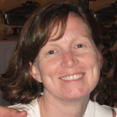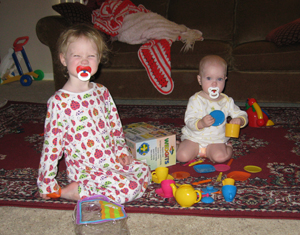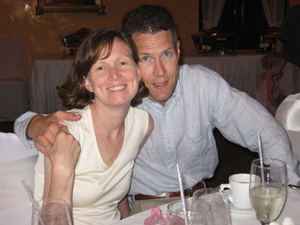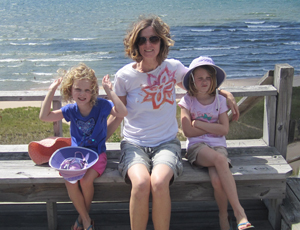Mother Diagnosed Never Gives Up

Name: Jennifer M.
Type of Cancer: Grade III Anaplastic Ependymoma
Diagnosed: Age 36, 2007
By: Jennifer
— Categories:
Adult
Brain
People of CERN: Jennifer's Story
In this short film, we meet Jennifer; who had to stop working due to her ependymoma treatment effects, but now focuses on spending quality time with her two daughters and husband.
Persistent Headaches
In February 2007, I began having headaches. My youngest daughter was about six weeks old and did not have a sleeping routine, so I blamed my headaches on lack of sleep. If I took Tylenol or drank caffeine, which I needed a lot of anyway, the headaches seemed to go away.
 Yet, my headaches persisted. In April, I went to see a family physician for a neurological exam; everything was normal. I felt relieved.
Yet, my headaches persisted. In April, I went to see a family physician for a neurological exam; everything was normal. I felt relieved.
However, my headaches got worse. I blamed it on stress and anxiety. In September, I went to a neurologist and, again, everything came back normal. My doctor recommended physical therapy, which initially made me feel better, but then my headaches continued to get worse. On November 15, I decided to have a CT scan of my brain.
My Scary Diagnosis and Surgery
My cell phone rang, it was the neurologist. There was something very large in my brain and I needed an MRI.
The MRI confirmed there was a tumor located close to where my headaches had been. Looking at the images of my brain, I thought my life as I knew it was over, and it would never be good again.
Within three weeks, I had surgery and a diagnosis – grade 3 anaplastic ependymoma. The first two days after surgery were pretty rough and I was scared out of my mind. My first night in the ICU I had a nervous breakdown. My ICU nurse sat with me, held my hand and said he would pray for me. I still pray for him every day.
Good News
The good news was that my neurosurgeon removed the entire tumor and the cancer had not spread to my spine, but I would need further treatment.
In January 2008, six weeks after surgery, I started radiation. My hair fell out, but I had a hat from my honeymoon that I thought brought me good luck.
In April, I went to MD Anderson Cancer Center in Houston. My neuro-oncologist at MD Anderson, Mark Gilbert, M.D., said that my MRI looked good. There were post-radiation scars, but no cancer. I had a wonderful summer.
 Return of the Tumor
Return of the Tumor
In September, I had a standard follow-up MRI, which showed the tumor had returned. I started chemotherapy – a combination of Lapatinib and Temodar. It made me very sick at first and then really tired.
In December, I had another MRI, which showed that the tumor in my brain had grown. Doctors stopped the “cocktail” that I was on and started me on a different chemotherapy drug called Cisplastin. I also took a medication that blocks the growth of blood cells called Avastin.
After six months of treatment I returned to Dr. Gilbert, who said, “The tumor is gone. Now we watch.” For over three years now my MRIs have all been good.
Cancer is Life-changing
Moving forward after treatment was really hard for me. I was depressed for a long time from the time of diagnosis through all of the treatments, but the depression lifted after Dr. Gilbert said the tumor was gone.
Cancer caused me to lose a significant part of my vision – I am half-blind in both eyes. I can’t drive, I need large print books and my daughters like getting away with things that I can’t see them doing.
I also had to stop working as a lawyer. I could not keep up with the amount of small-print reading that my job required. I still miss my job and the people I worked with, but I stay in touch; the social interaction is very good for me.
The upside is that I spend a lot more time with my family, especially my daughters. After my diagnosis, the thing I feared the most was that I would not be here with my girls as they grew up. Now, I walk them to school every day and volunteer at their school.
I’ve also tried to do things that I did not have time to do before. I learned to cook, got back into yoga, started running and took a French class.
My cancer experience has made me a better person. I am more confident. I trust myself and know that if something goes wrong, I can fix it.
 My Two-cents
My Two-cents
“Never, never, never give up.”– Sir Winston Churchill.
When I am waiting for my imaging test results – I have MRIs every six months – I always tell myself, “If it comes back, then I will kill it again.”
I’m a survivor. There are other survivors and you can survive too. Give yourself time to freak out, cry, believe that all is lost, but then start acting. Talk to your doctor, get a second opinion and make an informed decision about your treatment. Then go kick the piss-and-vinegar out of that tumor!
Resources
When I was searching for information on ependymoma, I did not find a lot. The American Cancer Society website was able to provide a lot of information about support groups, clinical trials and other sources of information in the area.
After my first visit to MD Anderson, I learned about the CERN Foundation. I get on the website regularly to learn about new clinical trials, events like the butterfly release and read about other people who’ve been affected by ependymoma.
The foundation gives me hope.
